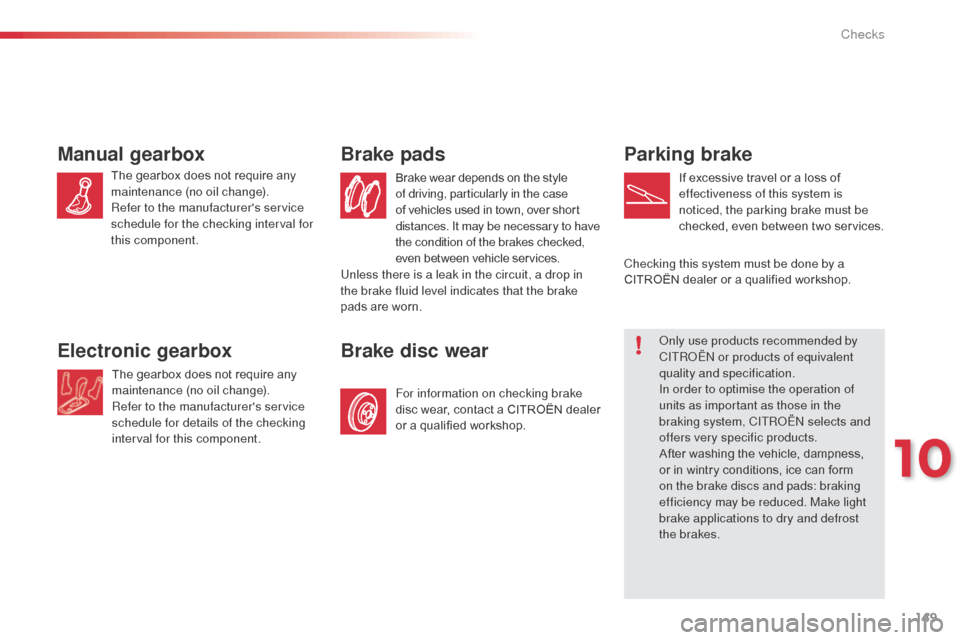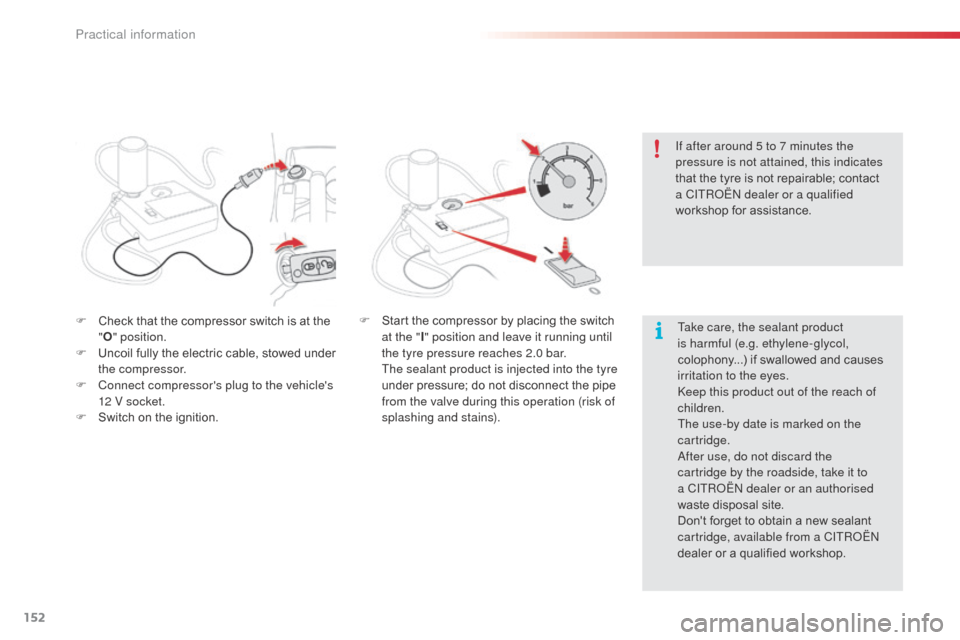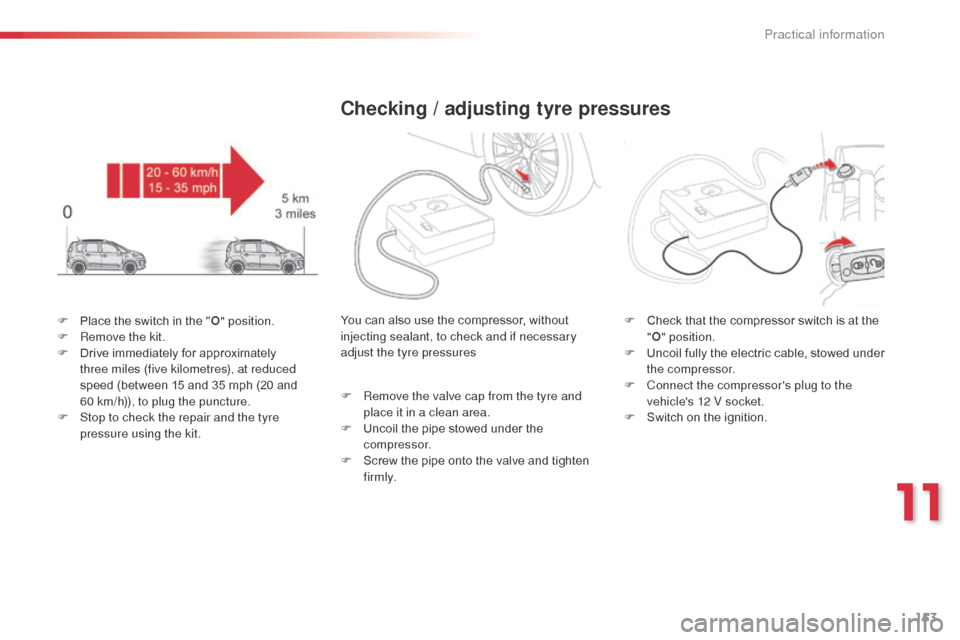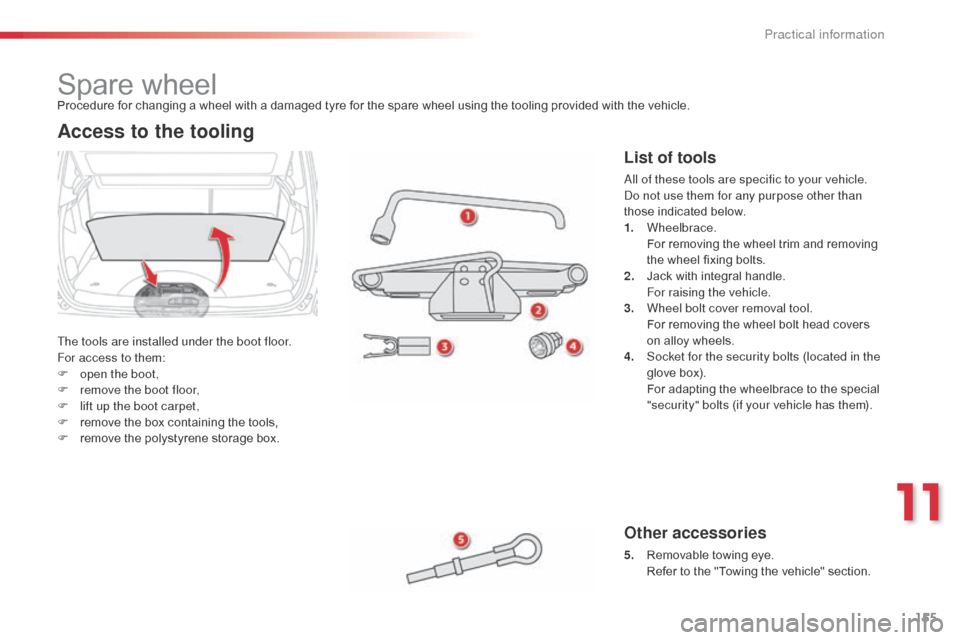Citroen C3 PICASSO 2016 1.G Owner's Manual
Manufacturer: CITROEN, Model Year: 2016, Model line: C3 PICASSO, Model: Citroen C3 PICASSO 2016 1.GPages: 292, PDF Size: 8.23 MB
Page 151 of 292

149
C3Picasso_en_Chap10_verification_ed01-2015
Parking brake
If excessive travel or a loss of
effectiveness of this system is
noticed, the parking brake must be
checked, even between two services.
Manual gearbox
The gearbox does not require any
maintenance (no oil change).
Refer to the manufacturer's service
schedule for the checking interval for
this component.For information on checking brake
disc wear, contact a CITROËN dealer
or a qualified workshop.
Brake disc wear
Brake wear depends on the style
of driving, particularly in the case
of vehicles used in town, over short
distances. It may be necessary to have
the condition of the brakes checked,
even between vehicle services.
Brake pads
The gearbox does not require any
maintenance (no oil change).
Refer to the manufacturer's service
schedule for details of the checking
interval for this component.
Electronic gearboxOnly use products recommended by
CITROËN or products of equivalent
quality and specification.
In order to optimise the operation of
units as important as those in the
braking system, CITROËN selects and
offers very specific products.
After washing the vehicle, dampness,
or in wintry conditions, ice can form
on the brake discs and pads: braking
efficiency may be reduced. Make light
brake applications to dry and defrost
the brakes.
Checking this system must be done by a
CITROËN dealer or a qualified workshop.
Unless there is a leak in the circuit, a drop in
the brake fluid level indicates that the brake
pads are worn.
10
Checks
Page 152 of 292

150
C3Picasso_en_Chap11_informations-pratiques_ed01-2015
Composition of the kit
1. 12 V compressor, with integral pressure gauge.
2.
S
ealant cartridge, with integral hose.
3.
Spe
ed limit sticker.
Access to the kit
This kit is installed in the storage box, under the
boot floor.
The speed limit sticker must be secured
to the interior of the vehicle in the
driver's field of vision, to remind you
that a wheel is in temporary use.
Comprising a compressor and a sealant
cartridge, it allows the temporary repair
of
a tyre so that you can drive to the nearest
garage.
It is designed to repair most punctures which
could affect the tyre, located on the tyre tread
or shoulder.
Do not exceed a speed of 50 mph
(80 km/h) when driving with a tyre
repaired using this type of kit.
The vehicle's electric system allows the
connection of a compressor for long
enough to inflate a tyre after a puncture
repair or for inflating a small inflatable
accessory.
Temporary puncture repair kit
Practical information
Page 153 of 292

151
C3Picasso_en_Chap11_informations-pratiques_ed01-2015
F Switch off the ignition.
F S ecure the speed limit sticker inside the
vehicle. F
U ncoil the pipe stowed under the
compressor.
F
C
onnect the pipe from the compressor to
the sealant cartridge.
F
T
urn the the sealant cartridge and secure it
in the cut-out provided on the compressor.
Avoid removing any foreign bodies
which have penetrated into the tyre. F
R emove the valve cap from the tyre to be
repaired, and place it in a clean area.
F
C
onnect the hose from the sealant
cartridge to the valve of the tyre to be
repaired and tighten firmly.
Repair procedure
11
Practical information
Page 154 of 292

152
C3Picasso_en_Chap11_informations-pratiques_ed01-2015
F Check that the compressor switch is at the "O " position.
F
U
ncoil fully the electric cable, stowed under
the compressor.
F
C
onnect compressor's plug to the vehicle's
12 V socket.
F
S
witch on the ignition. Take care, the sealant product
is harmful (e.g. ethylene-glycol,
colophony...) if swallowed and causes
irritation to the eyes.
Keep this product out of the reach of
children.
The use-by date is marked on the
cartridge.
After use, do not discard the
cartridge by the roadside, take it to
a CITROËN
dealer or an authorised
waste disposal site.
Don't forget to obtain a new sealant
cartridge, available from a CITROËN
dealer or a qualified workshop.
F
S tart the compressor by placing the switch
at the " I" position and leave it running until
the tyre pressure reaches 2.0 bar.
T
he sealant product is injected into the tyre
under pressure; do not disconnect the pipe
from the valve during this operation (risk of
splashing and stains). If after around 5 to 7 minutes the
pressure is not attained, this indicates
that the tyre is not repairable; contact
a CITROËN dealer or a qualified
workshop for assistance.
Practical information
Page 155 of 292

153
C3Picasso_en_Chap11_informations-pratiques_ed01-2015
F Place the switch in the "O" position.
F R emove the kit.
F
D
rive immediately for approximately
three miles (five kilometres), at reduced
speed (between 15 and 35 mph (20 and
60
km/h)), to plug the puncture.
F
S
top to check the repair and the tyre
pressure using the kit.
Checking / adjusting tyre pressures
You can also use the compressor, without
injecting sealant, to check and if necessary
adjust the tyre pressures
F
R
emove the valve cap from the tyre and
place it in a clean area.
F
U
ncoil the pipe stowed under the
compressor.
F
S
crew the pipe onto the valve and tighten
f i r m l y. F
C heck that the compressor switch is at the
" O " position.
F
U
ncoil fully the electric cable, stowed under
the compressor.
F
C
onnect the compressor's plug to the
vehicle's 12 V socket.
F
S
witch on the ignition.
11
Practical information
Page 156 of 292

154
C3Picasso_en_Chap11_informations-pratiques_ed01-2015
F Start the compressor by placing the switch at the " I" position and adjust the pressure
to the value shown on the vehicle's tyre
pressure label.
T
o deflate: press the black button on the
compressor pipe, at the valve connector.
F
O
nce the correct pressure is reached, put
the switch to the " O" position.
F
R
emove the kit then stow it.
Tyre under-inflation
detection
After repair of the tyre, the warning
lamp will remain on until the system is
reinitialised.
For more information on under-inflation
detection, refer to the corresponding
section.
Should the pressure of one or more
tyres be adjusted, it is necessary to
reinitialise the under-inflation detection
system.
For more information on under-inflation
detection, refer to the corresponding
section.
Practical information
Page 157 of 292

155
C3Picasso_en_Chap11_informations-pratiques_ed01-2015
Spare wheel
The tools are installed under the boot floor.
For access to them:
F
o
pen the boot,
F
r
emove the boot floor,
F
l
ift up the boot carpet,
F
r
emove the box containing the tools,
F
r
emove the polystyrene storage box.
Other accessories
5. Removable towing eye. R
efer to the "Towing the vehicle" section.
Access to the tooling
Procedure for changing a wheel with a damaged tyre for the spare wheel using the tooling provided with the vehicle.
List of tools
All of these tools are specific to your vehicle.
Do not use them for any purpose other than
those indicated below.
1.
Wheelbrace.
F
or removing the wheel trim and removing
the wheel fixing bolts.
2.
J
ack with integral handle.
F
or raising the vehicle.
3.
W
heel bolt cover removal tool.
F
or removing the wheel bolt head covers
on alloy wheels.
4.
S
ocket for the security bolts (located in the
glove box).
F
or adapting the wheelbrace to the special
"security" bolts (if your vehicle has them).
11
Practical information
Page 158 of 292

156
C3Picasso_en_Chap11_informations-pratiques_ed01-2015
Wheel with trim
When removing the wheel, first
detach the trim using the wheelbrace 1
pulling at the valve passage hole.
When refitting the wheel , refit the trim
starting by placing its notch facing the
valve and press around its edge with
the palm of your hand.
Access to the spare wheel
The spare wheel is installed in the boot under
t h e f l o o r.
The spare wheel is the "space-saver" type.
For access to it, refer to "Access to tooling" on
the previous page.
Fitting the "space-saver"
type spare wheel
If your vehicle is fitted with alloy wheels,
it is normal to notice, when tightening
the bolts on fitting, that the washers do
not come into contact with the "space-
saver" type spare wheel. The wheel is
secured by the conical contact of each
bolt.
Practical information
Page 159 of 292

157
C3Picasso_en_Chap11_informations-pratiques_ed01-2015
Taking out the wheel
F Unscrew the yellow central bolt, and remove it.
F
R
aise the spare wheel towards you from
the rear.
F
T
ake the wheel out of the boot.
Putting the wheel back in place
F Put the wheel back in its housing.
F R efit the yellow central bolt in the centre of
the wheel.
F
T
ighten fully until the central bolt clicks to
retain the wheel correctly. F
P ut the polystyrene storage box back in
place.
F
P
ut the box back in place and clip it.
11
Practical information
Page 160 of 292

158
C3Picasso_en_Chap11_informations-pratiques_ed01-2015
Removing a wheel
List of operations
F Remove the bolt cover from each of the wheel bolts using the tool 3 (with alloy
wheels only).
F
F
it the security socket 4 to the
wheelbrace
1
to slacken the security bolt
(if your vehicle has them).
F
S
lacken the other bolts using the
wheelbrace 1 o n l y.
Parking the vehicle
Immobilise the vehicle where it does not
block traffic: the ground must be level,
stable and non-slippery.
Apply the parking brake, switch off the
ignition and engage first gear* to lock
the wheels.
If necessary, place a chock against the
wheel diagonally opposite the wheel to
be changed.
You must ensure that the occupants get
out of the vehicle and wait where they
are safe.
Never go underneath a vehicle
supported by a jack; use an axle stand.
* Position R for an electronic gearbox. The jack must only be used to change a
wheel with a damaged tyre.
The jack does not require any
maintenance.
Practical information